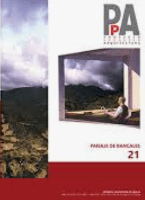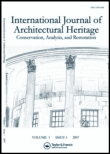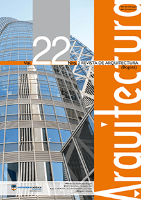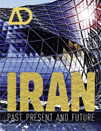
EGA-Revista de Expresion Grafica Arquitectonica
Scope & Guideline
Advancing Knowledge in Architectural Expression and Visual Arts
Introduction
Aims and Scopes
- Architectural Graphic Representation:
The journal emphasizes the importance of graphic representation in architecture, showcasing various methodologies for drawing, modeling, and visualizing architectural concepts. - Heritage Documentation and Analysis:
There is a consistent focus on documenting and analyzing architectural heritage through graphic means, including the use of digital technologies and traditional drawing techniques. - Interdisciplinary Approaches:
EGA encourages interdisciplinary research that combines architecture with art, history, and social studies, reflecting a multifaceted understanding of architectural practices. - Educational Methodologies in Architecture:
The journal explores pedagogical approaches to teaching architecture, particularly through graphic tools and visual communication, fostering a new generation of architects. - Cultural and Historical Contexts:
Research often contextualizes architectural practices within historical and cultural frameworks, examining how these influences shape contemporary architectural discourse.
Trending and Emerging
- Digital Technologies in Architecture:
There has been a significant increase in the exploration of digital tools and technologies for architectural representation, including virtual reality, augmented reality, and digital modeling techniques. - Sustainability and Environmental Design:
Emerging themes focus on sustainable architectural practices and the integration of environmental considerations into design processes, reflecting a broader societal shift towards sustainability. - Participatory Design and Community Engagement:
Research increasingly addresses participatory design methodologies that involve communities in architectural processes, emphasizing social responsibility and collaborative practices. - Graphic Narratives and Storytelling in Architecture:
The use of graphic narratives and storytelling as a means to communicate architectural concepts and histories is gaining traction, showcasing the power of visual communication in architecture. - Interdisciplinary Collaborations:
Collaborative projects that merge architecture with other disciplines such as art, sociology, and technology are becoming more prominent, indicating a trend towards holistic approaches in architectural research.
Declining or Waning
- Traditional Architectural Styles:
There appears to be a decreasing emphasis on the study of specific historical architectural styles, as the journal has shifted towards more contemporary and innovative approaches to architectural representation. - Purely Technical Drawings:
The focus on technical drawings devoid of contextual narrative or artistic exploration has diminished, with a preference for more conceptual and expressive forms of graphic representation. - Local Case Studies:
While local architectural studies were once prevalent, there is a noticeable trend towards global perspectives and comparative analyses in architectural research.
Similar Journals

Bulletin KNOB
Advancing Knowledge in Arts and HistoryBulletin KNOB, published by the KONINKLIJKE NEDERLANDSE OUDHEIDKUNDIGE BOND-KNOB, is a reputable Open Access journal that has been disseminating knowledge since 1899, with a continued commitment to making research accessible to all. Based in the Netherlands, this journal provides a platform for scholarly articles that span the fields of Conservation, History, and the Visual Arts and Performing Arts. With its 2023 Scopus rankings placing it in the top quartiles within its category, Bulletin KNOB is recognized for its significant contribution to the advancement of these disciplines. Researchers, professionals, and students alike are encouraged to engage with the journal's diverse content that bridges historical narratives with contemporary practices, fostering a deeper understanding of cultural heritage. The journal’s commitment to excellence is further reflected in its Q3 and Q4 quartile rankings, making it an essential resource for anyone dedicated to the study of the arts and humanities.

Proyecto Progreso Arquitectura
Transforming ideas into impactful architectural narratives.Proyecto Progreso Arquitectura, an esteemed academic journal published by UNIV SEVILLA, EDITORIAL, is dedicated to advancing the fields of Architecture, Arts and Humanities, History, Urban Studies, and Visual Arts. With an Open Access model since 2010, this journal facilitates the dissemination of innovative research and critical discourse among a global audience, fostering collaboration and insight within the academic community. Operating from Seville, Spain, the journal has successfully carved a niche in the architectural and design studies landscape, currently positioned in the Q3 category in Architecture and Urban Studies, and Q2 in History and Visual Arts as of 2023, demonstrating its growing impact and reputation. With an ISSN of 2171-6897 and an E-ISSN of 2173-1616, it also ranks commendably in Scopus across various disciplines, offering readers an invaluable resource for scholarly articles that contribute to the vibrant dialogues in architecture and its intersection with societal developments. The journal's approach not only encourages academic rigor but also embraces the practical implications of research, making it an essential read for researchers, practitioners, and students alike.

ARCHITECTURAL HISTORY
Illuminating the Intersection of History and DesignARCHITECTURAL HISTORY is a renowned journal published by Cambridge University Press, dedicated to advancing the field of architecture through scholarly research and critical analysis. Operating under ISSN 0066-622X and E-ISSN 2059-5670, this academic journal plays a pivotal role in disseminating knowledge related to the historical and theoretical dimensions of architecture. Though currently not open access, it offers invaluable insights for researchers and professionals interested in the evolution of architectural practices, spanning from the year 2002 to 2009 and continuing from 2011 to 2023. With a Q4 ranking in Architecture and a Q3 ranking in Visual Arts and Performing Arts as of 2023, ARCHITECTURAL HISTORY is well-positioned to contribute to the ongoing discourse in these fields. Furthermore, it holds commendable placements within the Scopus rankings, specifically 322/667 in Visual Arts and Performing Arts and 139/189 in Architecture, reflecting its growing influence. This journal serves not only as a platform for in-depth research but also as a critical space for scholarly exchange, making it an essential resource for students and academics alike who aspire to deepen their understanding of architectural heritage and its impact on contemporary practices.

Disegnarecon
Showcasing groundbreaking research in architecture and the arts.Disegnarecon is a distinguished open access journal published by UNIV L AQUILA that has been contributing to the fields of architecture, urban studies, and the visual and performing arts since its inception in 2008. With an ISSN of 1828-5961, this journal serves as a pivotal platform for researchers, practitioners, and students to disseminate innovative ideas and findings. Renowned for its rigorous peer-review process, Disegnarecon has achieved notable rankings in 2023, securing a Q2 quartile in Architecture, a Q3 quartile in Urban Studies, and a prestigious Q1 quartile in Visual Arts and Performing Arts, highlighting its academic significance. The journal’s commitment to fostering interdisciplinary dialogue is further emphasized by its impressive Scopus ranks, where it stands at Rank #136 in Visual Arts and Performing Arts and Rank #96 in Architecture. Aimed at advancing knowledge and practice in its respective fields, Disegnarecon is an essential resource for anyone dedicated to exploring the intersections of design, culture, and urban environments, encouraging active participation in contemporary discourse.

International Journal of Architectural Heritage
Preserving the Past, Shaping the Future.The International Journal of Architectural Heritage is a premier publication dedicated to the multidisciplinary fields of architecture, conservation, and visual arts. Published by TAYLOR & FRANCIS INC, this journal serves as a vital platform for scholars and practitioners who aim to advance knowledge in the preservation of cultural heritage and architectural innovation. With an impressive impact factor reflecting its critical acclaim, including rankings in the top quartile (Q1) across multiple categories in 2023, the journal is recognized as a key resource in Arts and Humanities, particularly in Visual Arts and Performing Arts and Conservation. Since its inception in 2007, the journal has consistently provided rigorous peer-reviewed research, offering enriching insights and fostering collaborations amongst students, researchers, and professionals committed to the future of architectural heritage. As it continues to influence the field through its diverse and impactful contributions, readers can expect to engage with leading-edge studies that not only illuminate current trends but also inspire innovative practices in safeguarding architectural legacies.

ABE Journal
Advancing Knowledge in Art and Visual CultureABE Journal, ISSN 2275-6639 (E-ISSN 2275-6639), is an esteemed open-access publication emerging from the collaborative efforts of INVISU-CNRS-INHA and the Institut National d'Histoire de l'Art located in Paris, France. Since its inception in 2012, the journal has facilitated unrestricted access to groundbreaking research in the fields of art history and visual studies, making significant contributions to interdisciplinary scholarship. With a commitment to disseminating high-quality research, ABE Journal plays a crucial role in fostering dialogue among scholars, practitioners, and students alike. Its diverse range of articles underscores the innovation and evolution within the art historical discourse, as it seeks to engage an international audience eager to explore contemporary methodologies and practices. The journal not only enhances accessibility to vital research but also aims to elevate academic standards within its field, making it a vital resource for those seeking to stay at the forefront of art history and visual culture.

Revista de Arquitectura-Bogota
Connecting Ideas, Inspiring Solutions in DesignRevista de Arquitectura-Bogota is a premier academic journal dedicated to the field of architecture, published by the esteemed Universidad Católica de Colombia, Facultad de Diseño. Since its inception in 1999, this Open Access journal has provided a vital platform for the dissemination of innovative research and critical discourse in architectural studies. With its commitment to the principles of open accessibility, the journal ensures that its diverse range of scholarly articles, case studies, and reviews are readily available to researchers, professionals, and students globally. The journal aims to foster collaboration and dialogue among architects, urban planners, and educators by publishing high-quality content that reflects contemporary issues and advancements in architecture. As an influential resource in the architectural community, Revista de Arquitectura-Bogota plays a crucial role in shaping the future of architectural practice and education in Latin America and beyond.

ArcHistoR-Architecture History Restoration
Preserving Heritage, Inspiring InnovationArcHistoR-Architecture History Restoration is an esteemed open-access journal published by UNIV MEDITERRANEA REGGIO CALABRIA since 2014, focused on the multifaceted domains of architecture, history, and visual arts. This journal serves as a vital platform for the dissemination of research findings, innovative methodologies, and critical discussions surrounding the restoration and history of architectural practices, appealing to a diverse audience of researchers, professionals, and students in these fields. With a commitment to scholarly excellence, ArcHistoR has positioned itself within the academic community, reflected in its ranking in the 2023 category quartiles, where it secured Q4 in Architecture and Q3 in both History and Visual Arts and Performing Arts. The journal facilitates global collaboration and knowledge sharing in its areas of expertise, further underscoring its relevance and significance. Based in Italy, effective communication and cooperation in the restoration community can flourish through the journal's purview. For those dedicated to expanding their understanding and contributing to the discourse on architectural history and restoration, ArcHistoR is an invaluable resource.

ARCHITECTURAL DESIGN
Unveiling Contemporary Design PracticesARCHITECTURAL DESIGN, a leading journal published by Wiley Periodicals, Inc., serves as a vital platform for discourse in the fields of architecture and visual arts. With an ISSN of 0003-8504 and an E-ISSN of 1554-2769, this esteemed publication offers comprehensive insights into contemporary design practices and emerging architectural theories. Established in the United States and continuously evolving from 2002 to 2024, the journal has secured a prominent position with a Q3 status in Architecture and an impressive Q1 ranking in Visual Arts and Performing Arts as of 2023. Its Scopus rankings further affirm its relevance, with a percentile ranking of 82nd in the Visual Arts category. Although it does not currently offer Open Access options, the journal remains dedicated to disseminating high-caliber research and innovative design strategies that engage a diverse readership of researchers, professionals, and students alike. The contributions published within its pages are instrumental in shaping the discourse around architecture, making ARCHITECTURAL DESIGN an indispensable resource for anyone passionate about the built environment.

TRANSACTIONS OF THE ANCIENT MONUMENTS SOCIETY
Unveiling the Stories of Ancient MonumentsTRANSACTIONS OF THE ANCIENT MONUMENTS SOCIETY is a distinguished journal published by the Ancient Monuments Society in the United Kingdom, focusing on the rich interplay between architecture, conservation, and religious studies as they pertain to ancient monuments and heritage. With an ISSN of 0951-001X, this journal serves as an essential platform for researchers, professionals, and students interested in exploring methodologies, case studies, and theoretical perspectives that enhance our understanding of historical preservation and cultural significance. Although it has been classified in Q4 quartiles in prominent categories such as Architecture, Conservation, and Religious Studies, the journal plays a vital role in fostering scholarly dialogue in these areas. Access options and updates are available, making it easier for enthusiasts and experts alike to engage with ongoing discussions surrounding ancient monuments. Despite its discontinued coverage in Scopus, the journal remains an invaluable resource for those aiming to contribute to the conservation discourse and to understand the relevance of ancient sites in contemporary society.